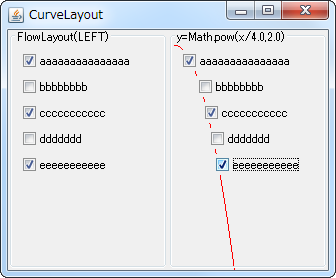
Here is the program to produce the interface as intended: 1 | import javax.swing.

To summarise, we can illustrate the structure of the layout as follows: In this example, we want two rows and two columns. With GridLayout, we can divide an area into equal size rows and columns by stating the number of rows and columns. To achieve the arrangement as shown above, we can use GridLayout as the layout manager. In the bottom container however, we are going to put four GUI widgets. Since there is only one widget that will be placed in the top container, we can use FlowLayout. Inside each of the region we use a container, and each container will be assigned its own layout manager. Remember that this is the layout manager for the main container. If you want more information about the BorderLayout manager, you can go here. Therefore, the border of these three regions will be extended to the edge of the left and right borders. Like in this example, we only want the top, middle and bottom regions, and do not need the left and right regions. If we do not use all five regions, the border will be adjusted accordingly.

They are called North, South, West, East, and Centerrespectively. BorderLayout allows an area to be divided into a maximum of five regions: top, bottom, left, right, and middle. In order to accomplish this, we can use BorderLayout as the layout manager. The top section is where we are going to put the question, the middle section is for the image, and the bottom section is for the buttons representing the answer options.Īs you can see, we need the middle section to be much bigger than the other two. We can divide the area inside the main container into three: top, middle, and bottom. Now lets imagine we divide the layout as follows: JPanel is also a type of container and can contain other JPanels. However, we cannot have a JFrame inside another JFrame, as JFrame can only be used as a main container. Therefore, if we want a mixture of different arrangement styles like in this example, we need to use multiple containers. A container can only be assigned one layout manager, but a container can contain another container. The style of arrangement inside a container depends on the layout manager we assign it to. Metaphorically, a container is like an open box where you can arrange your GUI widgets. Login Validation), we use JFrame to display GUI widgets in our program. Just like in all the previous examples(eg. You will see how your interactions are processed and your responses are executed in the second stage. However, when you run the program, it will not respond to any of your interaction. The table that follows lists every example in the Laying Out Components Within a Container lesson, with links to required files and to where each example is discussed.

In the first stage, you will see how we use the layout managers mentioned to display some GUI widgets. You will be introduced to JPanel and two other layout managers commonly used to arrange and display GUI widgets in Java: BorderLayout and GridLayout. create and layout buttons that will control deckītLayout( new GridLayout( 2, 2 ) ) įor ( int i = 0 i < controls.In the following program, you will see how we process input triggered by JRadioButtons using ItemEvent. JLabel label3 = new JLabel( "card three" ) Ĭard3.add( new JButton( "North" ), BorderLayout.NORTH ) Ĭard3.add( new JButton( "West" ), BorderLayout.WEST ) Ĭard3.add( new JButton( "East" ), BorderLayout.EAST ) Ĭard3.add( new JButton( "South" ), BorderLayout.SOUTH ) Ĭard3.add( label3, BorderLayout.CENTER ) ĭeck.add( card3, label3.getText() ) // add card to deck set up card3 and add it to JPanel deck JLabel label2 = new JLabel( "card two", SwingConstants.CENTER ) ĭeck.add( card2, label2.getText() ) // add card to deck set up card2 and add it to JPanel deck JLabel label1 = new JLabel( "card one", SwingConstants.CENTER ) ĭeck.add( card1, label1.getText() ) // add card to deck set up card1 and add it to JPanel deck Public class FlowLayoutDemo extends JFrame You can align the components left, right or center (default). This is the most basic layout manager, components are placed from left to right as they were added, when the edge is reached the components are put on the next line.

unlike GridLayout each component size can vary and components can be added in any order. Allows components to be arranged left-to-right or top-to-bottom in a container


 0 kommentar(er)
0 kommentar(er)
